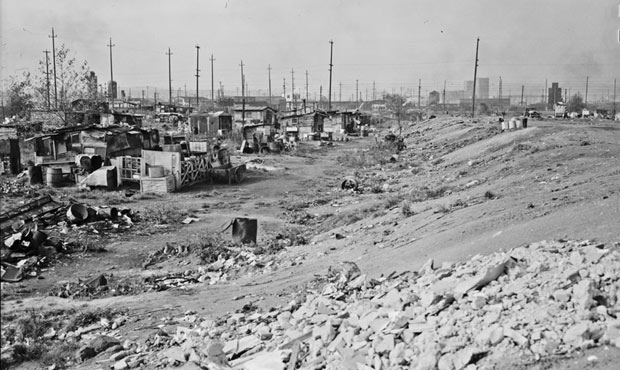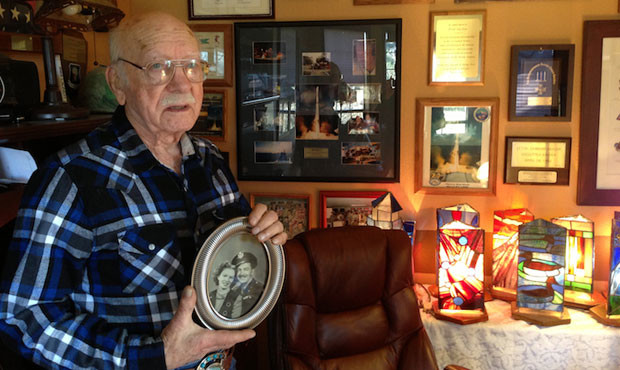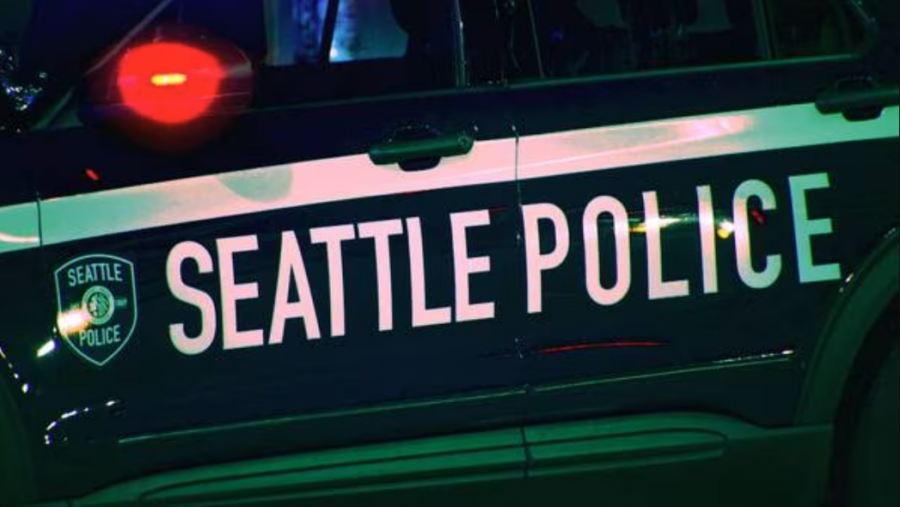A look at Seattle’s homeless ‘Shacktown’ history
Jan 28, 2016, 9:05 AM | Updated: Jun 29, 2016, 9:20 am

"Shacks in Shantytown" along the 6th Avenue South Garbage Fill. (Seattle Municipal Archives Photograph Collection)
(Seattle Municipal Archives Photograph Collection)
Debates about homelessness are raging in Seattle. Homeowners are anxious for the government to do something about homeless encampments encroaching on residential neighborhoods. Homeless people coming here from out of town are mostly criminals. Violence among people living in makeshift shelters near Beacon Hill is making headlines and putting political pressure on the mayor and city council.
Today’s headlines, right? Yes, but the same could be said — and was said — in Seattle in 1939. Like any complex issue these days, there’s much in the way of history and context that doesn’t often make it into the daily news.
As early as 1904, The Seattle Times described a place called “Shacktown” in the tideflats west of Pioneer Square. According to the newspaper, that community stretched along most of the old waterfront, from “Spokane Avenue toward Denny Way.”
In the early years of the 20th century, Seattle was becoming and industrial center, and much more urban and crowded than it had been just a few decades earlier. Public officials had new responsibilities to manage, such as food safety and sewage disposal, in order to prevent outbreak of diseases like cholera and tuberculosis.
In Seattle, health officials came to see Shacktown as a threat to public health. In reality, it’s likely that some version of Shacktown had likely been a part of downtown from as early as the 1850s, just after settlers arrived, but the stakes became higher as the city grew. And like any community in those years, alcoholism likely contributed to a certain base level of chronic homelessness in the urban core, or the “Skid Road” area around Yesler Way.
Health officials said Shacktown was rat-infested, and rats carried fleas that could carry bubonic plague. In 1909, the 105 “hovels” that then made up the waterfront Shacktown were ordered vacated, and were burned down. Two of the these hovels, the newspaper said, were functioning as grocery stores.
Newspaper accounts at the time also noted that the 1909 encampment had been built in a spot where a similar encampment had been destroyed once before two years earlier.
By 1913, another Seattle Times article praised Health Commissioner J.E. Crichton for leading the charge in which Seattle’s Shacktown had been “wiped from the map.” In that account, the total number of shacks destroyed by Crichton’s campaign was estimated at 1,200, and total population of Shacktown that had been displaced was estimated at 3,500. The disparity between the 1909 and 1913 figures requires more research to reconcile.
Coincidentally, the total population of Seattle just 23 years earlier was also 3,500. The city had boomed in the 1880s and 1890s, and by 1910, the population was a whopping 237,194. Seattle had become a big city, and with that came big city problems.
It’s not clear where all those people who were displaced from Shacktown went, but a keyword search finds little mention of Shacktown until the early 1930s.
By then, Shacktowns were present in several places on the edge of urban Seattle: on the waterfront west of Pioneer Square, probably Seattle’s original Shacktown; south of downtown at a garbage dump at Sixth Avenue and Lander Street near the present site of the Starbucks headquarters (this particular Shacktown was known as “Hooverville,” and was named in honor of the Republican president in office at the start of the Great Depression); west of Beacon Hill, near the present site of The Jungle, and known to some as “Republican Heights,” which is apparently a more generic variation of Hooverville; adjacent to Jefferson Park on Beacon Hill on a piece of land known as the Sears tract; and under and near the Garfield Street Bridge to Magnolia, and known as the Interbay Shacktown.
Throughout the 1930s, Shacktown shows up again and again in newspaper reports of fights, stabbings, shootings, theft, and at least one marijuana sale. From an anecdotal perspective, crime was fairly common in Shacktown in those years.
As public and political debate heated up about what to do with Seattle’s Shacktown residents, a census was conducted in 1938 by a Shacktown resident named Byrd Kelso. Byrd told the city council that there were a total of 22,204 shacks in Seattle, and that 64 percent of the residents of Seattle’s Shacktowns were single men. It’s unclear what Kelso’s census methodology was, but his figure was apparently accepted as accurate, and was quoted in multiple issues of the newspaper around this time.
In an article about the census, Seattle Police Chief William H. Sears blames “an influx of Southern Negro ex-convicts [for] many sluggings in the South End, traceable to the shacktown.”
The debate in the late 1930s was most like the current debate about what to do about homelessness. It wasn’t just Seattle that was faced with large populations of homeless people; the Great Recession hit most the United States hard and the problem of homeless was a national crisis.
As various solutions were suggested, Seattle Times’ editorials in 1938 and 1939 weighed in on the debate.
Seattle is more prone to attracting the homeless: “Every American city of any size has long had a shacktown of sorts. In coastal cities the tendency has been toward the waterfront; in the interior, shacktown usually nestles by the riverside or will be found on ‘the other side of the tracks.’ Seattle, with both salt and fresh waterfronts, affords unusual facilities for shacktown development.”
Many homeless people don’t want to live in shelters or low-cost housing: “Habituated shacktown dwellers, long free from rental obligations, may prefer to remain ‘as is,’ rather than pay any rent at all.”
The Seattle Times also believed that the real solution was not public housing, it was employment: “Boresome as it may be to say one thing over and over again, the fact remains that the way to help people out of shacktowns, and to abate, if not to abolish shacktowns, is to bring business and industry back to a point where employment at living wages will be within reach of all who are willing to work.”
Public housing came into the mix when the 1937 Housing Act made federal dollars available to local jurisdictions who were willing to build and manage affordable housing. The Seattle Housing Authority was formed in the late 1930s, and soon began work on the Yesler Terrace housing project which opened in 1941. The Housing Authority of King County (nowadays known as the King County Housing Authority) was formed in 1940, and built housing for miners in southeast King County, and defense plant workers in White Center and Kirkland during World War II.
As it turned out, World War II was the major catalyst that did more than anything else to eradicate Seattle’s Shacktowns. Many of the Shacktowns were actually situated on vacant public land that was of little value during the Great Depression. But once the war was looming in Europe and Asia, and well before the attack on Pearl Harbor, and federal dollars were being pumped into defense projects, that public land became valuable space for wartime use. The shacks had to go. There was a war on!
The waterfront Shacktown was burned down in April 1941 to make room for a dock; the Interbay Shacktown was burned down in May 1942 to make way for an addition to the US Navy supply depot at Pier 41. It’s unclear what became of the Shacktown west of Beacon Hill and the Shacktown on the Sears tract.
With a war to be won, unemployment nearly evaporated as money flowed into local industry and just about anybody could get a job. Even so, homelessness likely didn’t go away during World War II (in fact, many defense workers had trouble finding places to live since demand was so high), but the population of homeless in Seattle certainly must have dropped significantly in the early 1940s.
A booming economy after the war and into the 1950s and 1960s, along with new and expanded social safety net programs, also contributed to homelessness remaining fairly invisible (other than in the urban core) in Seattle until the recession of the late 1970s and early 1980s.
Editor’s note: Feliks Banel does contract work as a historian and video producer for the King County Housing Authority.













